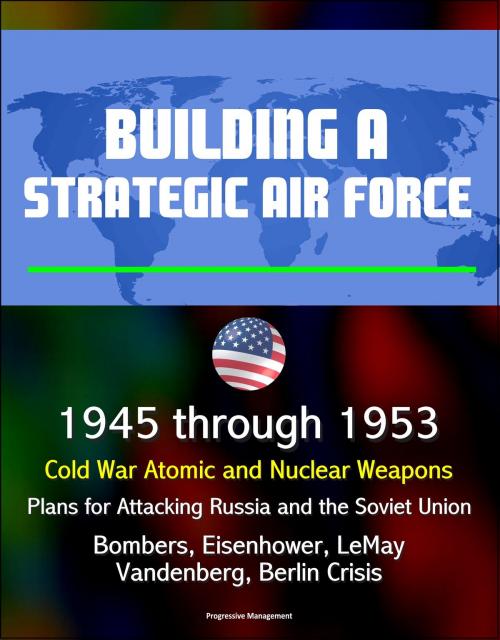Building a Strategic Air Force: 1945 through 1953, Cold War Atomic and Nuclear Weapons, Plans for Attacking Russia and the Soviet Union, Bombers, Eisenhower, LeMay, Vandenberg, Berlin Crisis
Nonfiction, History, Military, Nuclear Warfare, Aviation| Author: | Progressive Management | ISBN: | 9781310864520 |
| Publisher: | Progressive Management | Publication: | November 14, 2014 |
| Imprint: | Smashwords Edition | Language: | English |
| Author: | Progressive Management |
| ISBN: | 9781310864520 |
| Publisher: | Progressive Management |
| Publication: | November 14, 2014 |
| Imprint: | Smashwords Edition |
| Language: | English |
On March 21, 1946, by order of Headquarters, Army Air Forces, Continental Air Forces received a new name, becoming the Strategic Air Command. This administrative procedure was intended to give some suggestion as to what the mission of that command was to be under the new structure of the air arm. One effect the order had was upon the American language. Very soon after that order was issued, "SAC" —pronounced as a word of one syllable — would be commonplace usage of everyone in or involved with the command. This volume recounts how the Army Air Forces and its successor organization, the U.S. Air Force, organized, trained and equipped strategic air forces for a worldwide mission. The period of history covered in this volume has been heavily studied. It is the opening era of the "Cold War" between the Union of Soviet Socialist Republics and the western countries led by the United States.
This volume presents a larger focus. It concerns the American air force's efforts to build a strategic force. The emphasis is on the leaders, the political context, programs, and forces. A significant element of the subject concerns air doctrine, but here this is seen primarily in terms of the experience the leadership of the air arm had had with air warfare.
The strategic force here described was not only by 1953 the premier command of the Air Force. It was the centerpiece of national strategy. The intention here will be to connect the development of the strategy of atomic deterrence with the actual composition and nature of that force. The importance of the Air Force as an institution in American life, and the role of the strategic force in that institution, would seem to establish the importance of the subject.
American air leaders believed that the consequences of the air arm's not being ready to carry out such an offensive, through failure to plan or for any other reason, could be grave. These, then, were disturbing times. In this connection, there are many in the Soviet Union today who consider the practice of falsifying the historical record for current political purposes to have been one of the most corrupting factors in the life of that country.
Part I * Postwar Reorganization, 1945 - 1947 * I. Air Power and the Airmen: 1945 * Air Power and Strategy * Building a Strategic Air Force, 1917-1945 * The Postwar Challenge * II. The Case for a Postwar Air Force * A New Strategic World * Demobilization and Occupation * Planning for Strategic Air Power * III. The Beginnings of a Strategic Air Force * Air Power Deferred * The Strategic Force and Demobilization * The Strategic Force and the Fifty-five Group Program * Modernizing the Bomber Force * IV. The Uncertain Phase * Understanding the Bomb * Command of Strategic Forces * Planning for Atomic War * Part II * Austerity and Strategic Air Power, 1947 -1950 * V. Decision for a Strategic Air Force * Making the Case for Air Power: Finletter and Brewster * A Program for Atomic Readiness: JCS 1745 / 5 * Aircraft for the Strategic Offensive * VI. The Year of Crisis * Toward a Crisis Budget * Roles, Missions, and Budgets * The Berlin Crisis * Containment, Deterrence, and NSC-20 / 4 * "The Hollow Threat" and LeMay * VII. The Priority Mission * Aircraft for Deterrence * Return to Austerity * Modernization and Standardization * VIII. Challenges to Strategy * The Challenge at Home * Facing the Challenge * The External Challenge: The Soviet Bomb * The Strategic Force at the Ready: SAC in 1950 * Part III * Expansion of the Strategic Force, 1950 -1953 * IX. Limited War, Atomic Plenty, and Rearmament * Deterrence at Risk * Rearmament Begins * The Role of Nuclear Weapons * Expanding the Strategic Force * An Investment in Air Power * X. "Never Before Surpassed" * Medium Bombers in Korea * Expansion and Professionalism * Planes and Weapons, 1950-1953 * Basing for a Global Strike Force * From New Phase to New Look
On March 21, 1946, by order of Headquarters, Army Air Forces, Continental Air Forces received a new name, becoming the Strategic Air Command. This administrative procedure was intended to give some suggestion as to what the mission of that command was to be under the new structure of the air arm. One effect the order had was upon the American language. Very soon after that order was issued, "SAC" —pronounced as a word of one syllable — would be commonplace usage of everyone in or involved with the command. This volume recounts how the Army Air Forces and its successor organization, the U.S. Air Force, organized, trained and equipped strategic air forces for a worldwide mission. The period of history covered in this volume has been heavily studied. It is the opening era of the "Cold War" between the Union of Soviet Socialist Republics and the western countries led by the United States.
This volume presents a larger focus. It concerns the American air force's efforts to build a strategic force. The emphasis is on the leaders, the political context, programs, and forces. A significant element of the subject concerns air doctrine, but here this is seen primarily in terms of the experience the leadership of the air arm had had with air warfare.
The strategic force here described was not only by 1953 the premier command of the Air Force. It was the centerpiece of national strategy. The intention here will be to connect the development of the strategy of atomic deterrence with the actual composition and nature of that force. The importance of the Air Force as an institution in American life, and the role of the strategic force in that institution, would seem to establish the importance of the subject.
American air leaders believed that the consequences of the air arm's not being ready to carry out such an offensive, through failure to plan or for any other reason, could be grave. These, then, were disturbing times. In this connection, there are many in the Soviet Union today who consider the practice of falsifying the historical record for current political purposes to have been one of the most corrupting factors in the life of that country.
Part I * Postwar Reorganization, 1945 - 1947 * I. Air Power and the Airmen: 1945 * Air Power and Strategy * Building a Strategic Air Force, 1917-1945 * The Postwar Challenge * II. The Case for a Postwar Air Force * A New Strategic World * Demobilization and Occupation * Planning for Strategic Air Power * III. The Beginnings of a Strategic Air Force * Air Power Deferred * The Strategic Force and Demobilization * The Strategic Force and the Fifty-five Group Program * Modernizing the Bomber Force * IV. The Uncertain Phase * Understanding the Bomb * Command of Strategic Forces * Planning for Atomic War * Part II * Austerity and Strategic Air Power, 1947 -1950 * V. Decision for a Strategic Air Force * Making the Case for Air Power: Finletter and Brewster * A Program for Atomic Readiness: JCS 1745 / 5 * Aircraft for the Strategic Offensive * VI. The Year of Crisis * Toward a Crisis Budget * Roles, Missions, and Budgets * The Berlin Crisis * Containment, Deterrence, and NSC-20 / 4 * "The Hollow Threat" and LeMay * VII. The Priority Mission * Aircraft for Deterrence * Return to Austerity * Modernization and Standardization * VIII. Challenges to Strategy * The Challenge at Home * Facing the Challenge * The External Challenge: The Soviet Bomb * The Strategic Force at the Ready: SAC in 1950 * Part III * Expansion of the Strategic Force, 1950 -1953 * IX. Limited War, Atomic Plenty, and Rearmament * Deterrence at Risk * Rearmament Begins * The Role of Nuclear Weapons * Expanding the Strategic Force * An Investment in Air Power * X. "Never Before Surpassed" * Medium Bombers in Korea * Expansion and Professionalism * Planes and Weapons, 1950-1953 * Basing for a Global Strike Force * From New Phase to New Look















